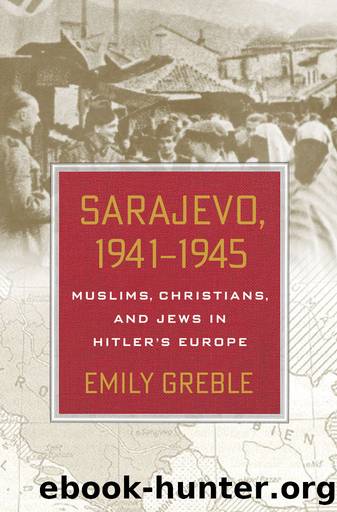Sarajevo, 1941â1945: Muslims, Christians, and Jews in Hitler's Europe by Greble Emily

Author:Greble, Emily
Language: eng
Format: epub
ISBN: 978-0-8014-6121-7
Publisher: Cornell University Press
Political Transition: A Return to Autonomy and Pluralism
Whereas the refugees offered a negative rallying point for the town, the crisis itself served as a positive catalyst in reviving the cityâs traditional networks. In the absence of state assistance, private institutions that assumed responsibility for refugee services gradually acquired more and more power in determining how the city would function. This new dynamic became a critical means of developing and sustaining cross-cutting civic bonds that had long been the foundation of the community. The crisis also served as the impetus for reviving local political traditions that the Ustasha regime had attempted to destroy.
Under pressure from the German and Italian commands to get the country under control, PaveliÄâs regime decided to transfer more power to Muslimsâparticularly a subgroup of Sarajevoâs Muslims who had supported the Axis but had been lukewarm to the Ustashas. In July 1942, the Ministry of the Interior appointed a new mayor, Mustafa SoftiÄ, a member of the wealthy, politically connected Muslim elite.100 Born in fin-de-siècle Sarajevo, SoftiÄ had graduated from the local Islamic high school and served in the Austro-Hungarian army during the First World War. In the interwar period, he had worked for the Islamic Religious Communityâs vakuf and the cityâs savings bank, and he was a member of the Yugoslav Muslim Organization. At the start of the war, SoftiÄ was not a public figure, though his father-in-law, Uzeir-aga HadžihasanoviÄ, was a prominent Sarajevo merchant and an important local actor (and no doubt had played a part in getting SoftiÄ the job). HadžihasanoviÄ, a close friend of Mehmed Spaho in the interwar era, had been accused of nepotism in the past, having pushed his son-in-law into positions of power in order to manipulate the political dynamic behind the scenes.101 SoftiÄ and HadžihasanoviÄ had supported the German occupation of Yugoslavia but were among those Muslims who would have preferred that Bosnia become a German protectorate rather than a part of the NDH.102 Like so many members of the cityâs Muslim elite, they signed (and possibly were among the authors) of the famous Muslim resolution in October 1941. While the Ustasha police did not arrest or sanction the signers, they kept a close watch on them afterward. SoftiÄâs appointment as mayor can thus be seen as an Ustasha concession to form a more genuine coalition with Muslims.
When SoftiÄ assumed office in July 1942, Sarajevoâs humanitarian crisis had been continuing unabated. Disease, especially typhus, was still rampant, forcing city health officials to shut down public buildings and quarantine the sick. By September, the cityâs hospital was in such a state of âunhygienic filth and disarrayâ that local Ustasha officials claimed it was contributing to rather than curing infections.103 Moreover, the influx of refugees remained steady, aggravating the social, health, and housing problems.104 Exacerbating the already tense political and military situation was the rivalry among the Italians, Germans, and Ustashas for control over the region. The Germans and Italians frequently intervened in local affairs, pressuring the mayorâs office to defer to their interests.
Download
This site does not store any files on its server. We only index and link to content provided by other sites. Please contact the content providers to delete copyright contents if any and email us, we'll remove relevant links or contents immediately.
| Africa | Americas |
| Arctic & Antarctica | Asia |
| Australia & Oceania | Europe |
| Middle East | Russia |
| United States | World |
| Ancient Civilizations | Military |
| Historical Study & Educational Resources |
The Third Pole by Mark Synnott(914)
Money for Nothing by Thomas Levenson(898)
The Economist (20210109) by calibre(897)
Christian Ethics by Wilkens Steve;(824)
Made in China by Anna Qu(812)
The Age of Louis XIV: The Story of Civilization by Will Durant(788)
Reopening Muslim Minds by Mustafa Akyol(768)
Nonstate Warfare by Stephen Biddle(766)
100 Posters That Changed The World by Salter Colin T.;(750)
Culture by Terry Eagleton(724)
The Shortest History of China by Linda Jaivin(721)
The Great Pyramid Void Enigma by Scott Creighton(721)
The Irish Buddhist by Alicia Turner(717)
Ideology by Eagleton Terry;(696)
Routledge Handbook of Contemporary India by Knut A. Jacobsen(694)
Sybille Bedford by Selina Hastings(656)
The Jews of Silence: A Personal Report on Soviet Jewry by Elie Wiesel(650)
Objects of Vision by Saab A. Joan;(639)
Banaras: CITY OF LIGHT by Diana L. Eck(631)
